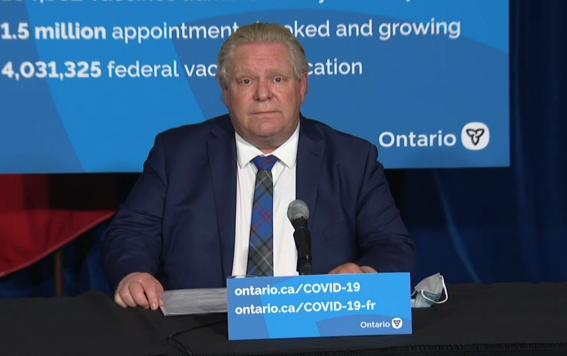TORONTO – The Province of Ontario has issued a third state of emergency as well as another stay-at-home order, and non-essential retail stores must close to in-person shopping.
“The risks are greater and the stakes are higher,” Premier Doug Ford stated of the third wave of the COVID-19 pandemic during an April 7 press conference.
“Despite everything we’ve done so far, things are getting worse as these new variants start to spread.”
Under the new measures introduced on Wednesday, most non-essential retailers are restricted to curbside pick-up and delivery, via appointment.
Grocery stores and pharmacies are permitted to stay open for in-person shopping, with the previously-announced 50% capacity limit.
Big box retail stores are restricted to selling just grocery, pharmacy/health care, cleaning, pet care and personal care items for in-person shopping, a move some critics have been calling for since the first wave of the COVID-19 pandemic.
Garden centres are allowed to stay open, with 25% capacity.
Some businesses can remain open by appointment only and with 25% capacity, such as mechanics, boat and vehicle sales, and stores that sell eyewear, safety supplies, mobility devices and telecommunications equipment.
Schools and child care centres will remain open to in-person learning, though several public health units have already closed schools in their regions.
The new province-wide restrictions, expected to last at least four weeks, come in the wake of criticism of the “emergency break shutdown” Ford announced last week.
Critics, including top health officials in the province, argued those measures will not do enough to slow the spread of the virus during the third wave.
Ontario reported another 3,215 cases of the virus on Wednesday, the highest single-day total since Jan. 17, during the peak of the second wave. The province also reported 17 COVID-related deaths on April 7.
The seven-day moving average of daily cases climbed to 2,988 on Wednesday, its highest point since Jan. 18.
There are now over 500 people with COVID-19 being treated in hospital intensive care units (ICUs), whereas during the second wave ICU admissions peaked at 420.
Provincial health officials warned last week that Ontario’s ICU admissions will likely top 800 this month, even if a four-week stay-at-home order was issued.
At that level, they said, doctors would have to implement a triage protocol to decide who receives care.
Leading up to Ford’s “emergency brake shutdown” last week, health officials had advocated for a stay-at-home order lasting at least two weeks, preferably four.
Modelling shows a month-long order, combined with keeping up with vaccinations, could help keep daily case counts between 1,000 and 1,500 by the end of April. A two-week stay-at-home order would mean daily infections would be about 2,000, the data suggests.
“These next four weeks are absolutely critical … hope is on the horizon,” Ford stated on Wednesday.
“The decisions we make now … will be the difference between life and death for thousands of people.”
Ford also announced on Wednesday the province’s vaccination rollout is ramping up, with clinics immediately addressing COVID-19 hotspots such as the Toronto and Peel regions. Vaccines in those areas will be made available to those 18 and older.
And starting next week, special education workers across the province – and all education workers in Ontario “hotspots” – can be vaccinated.
Ford said that as long as vaccine shipments arrive as planned, 40% of Ontarians could be vaccinated by the end of the stay-at-home order.
“Please folks, this is how you can help us,” Ford said, urging all Ontarians to be vaccinated as soon as they are eligible.
For a complete list of the new restrictions visit covid-19.ontario.ca.




